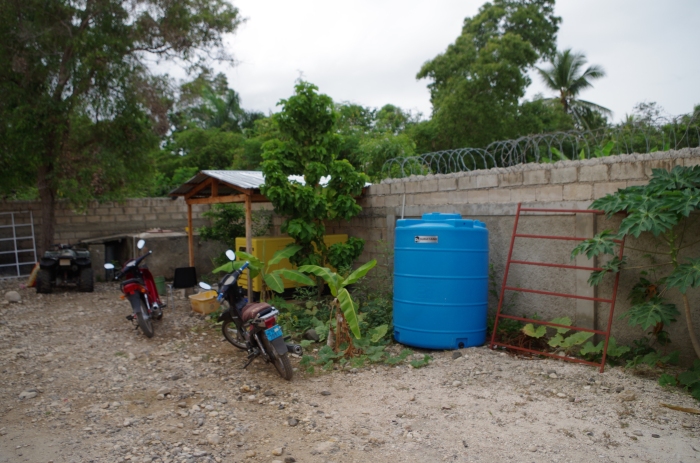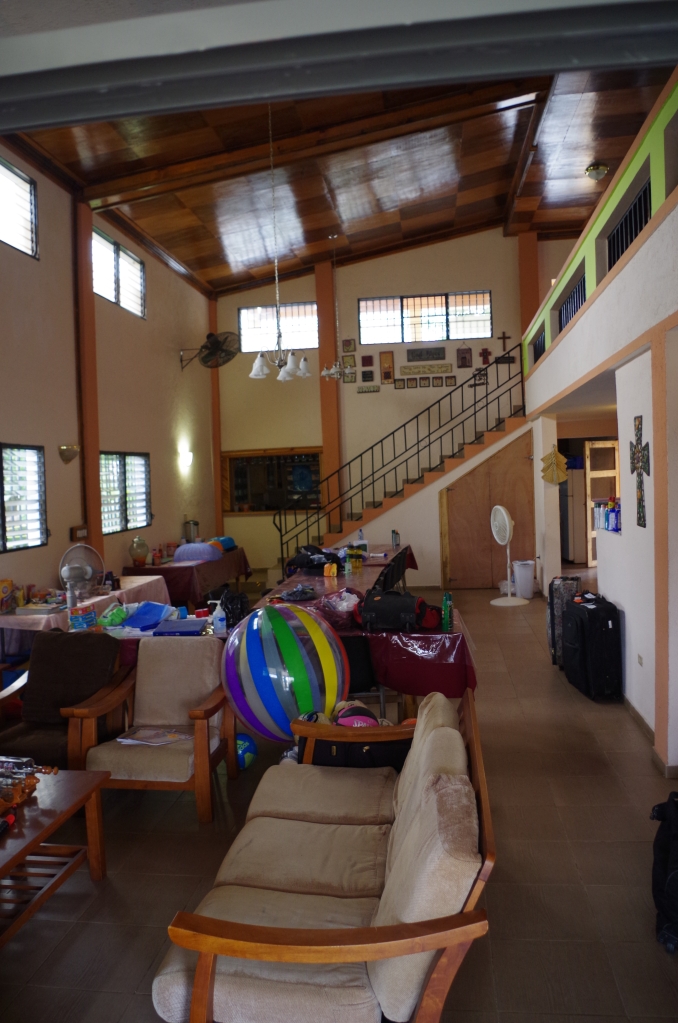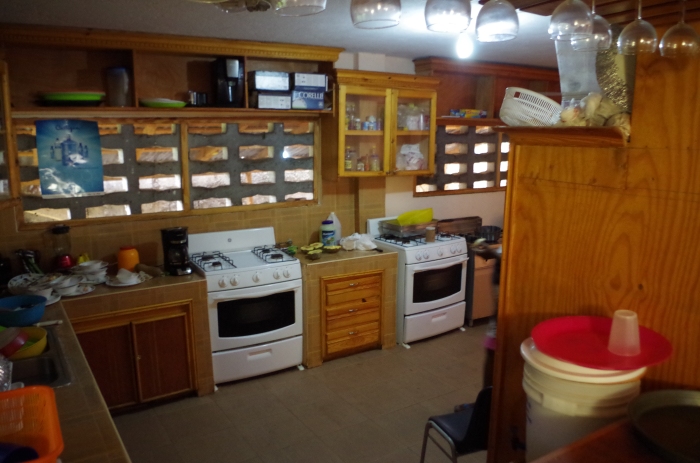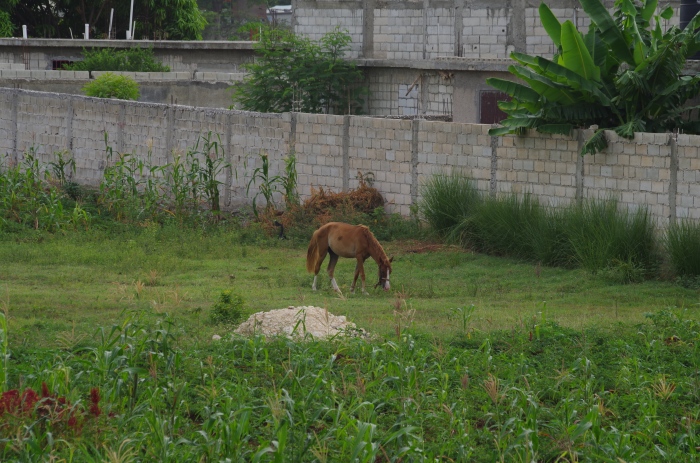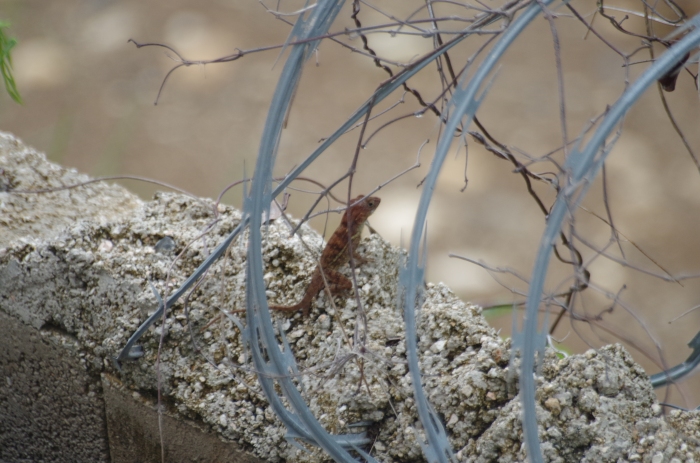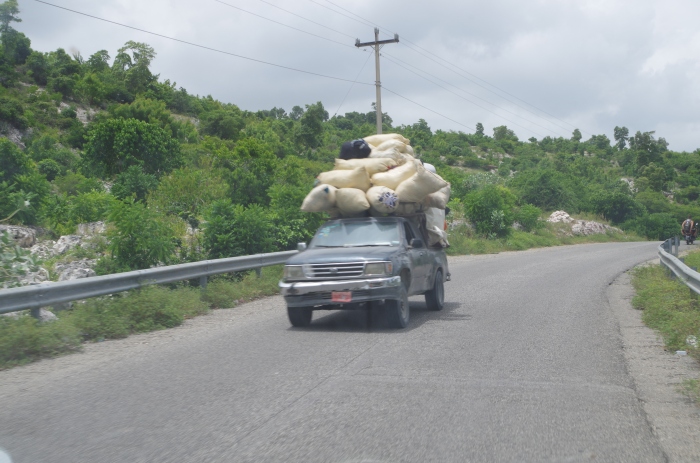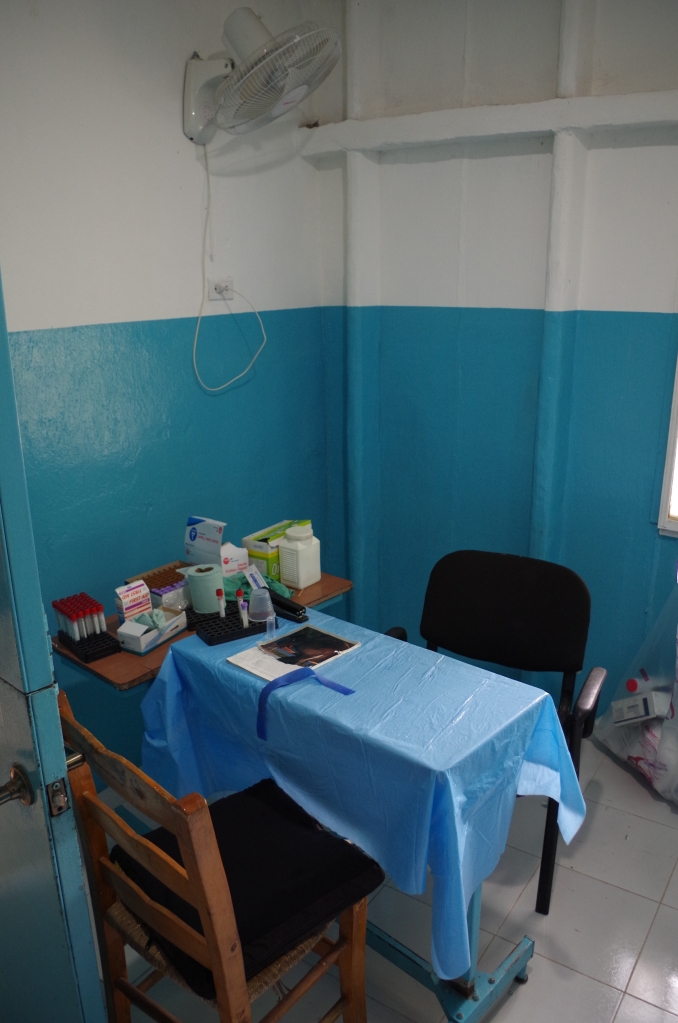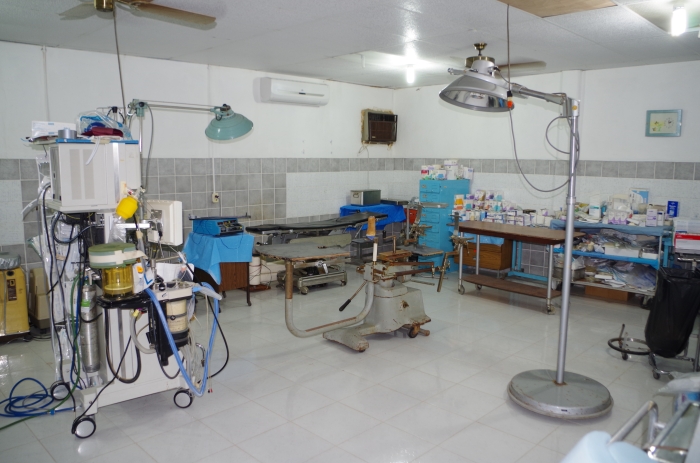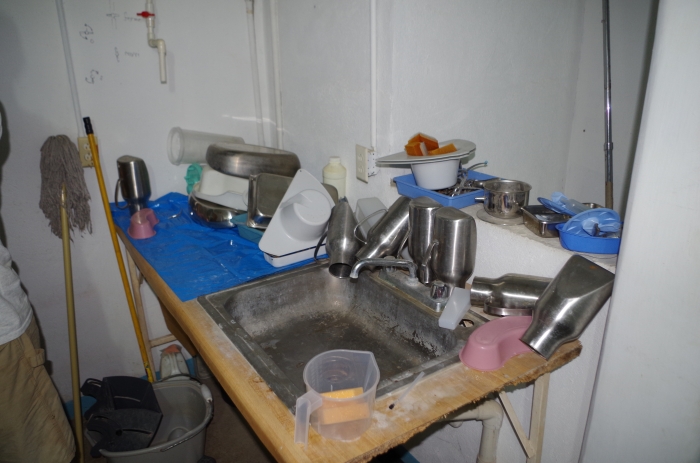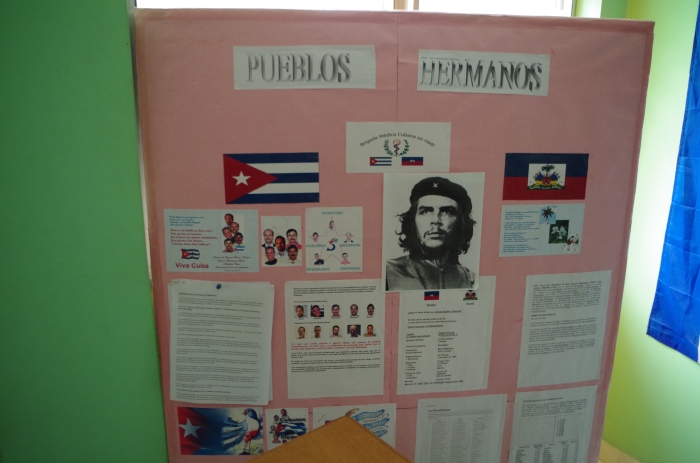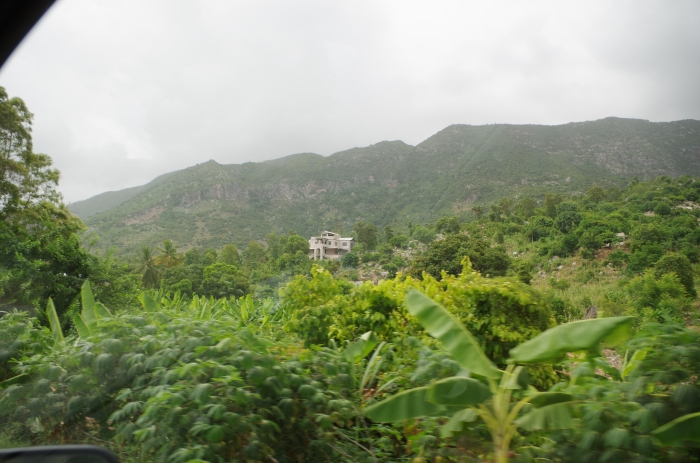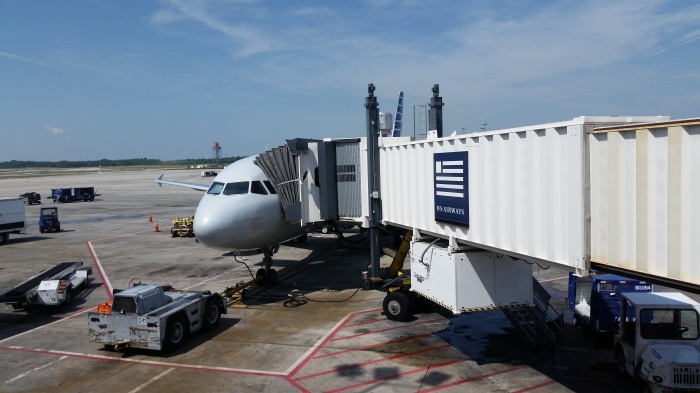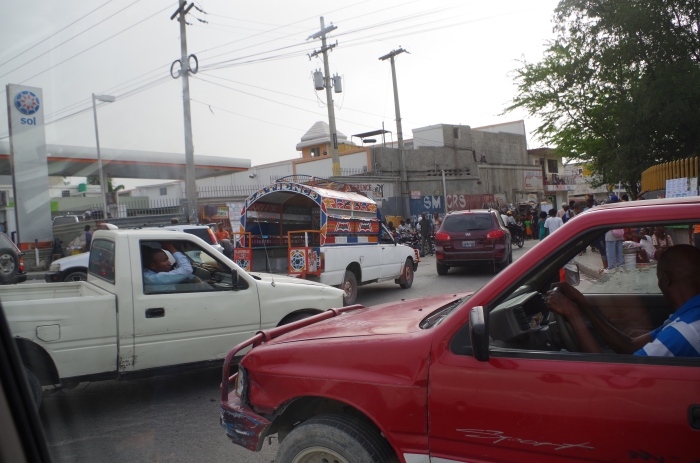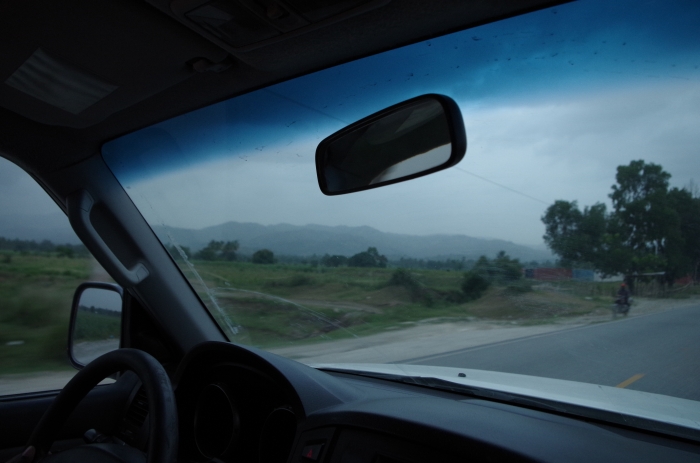Departing for my Ohio home
Therefore, after a mostly sleepless night (as I mentioned in the previous post, it was HOT until the AC cooled the room to comfort… and then it kept cooling until it was COLD)… we got up bright and early and piled into the car.
And then realized that the tap tap parked in the compound with us was blocking us in, and we had no idea where the key was. So I got Erin into the driver’s seat of it and gave her a quick lesson in “stick shift in neutral and be ready to hit the brake” and Steven and I pushed the truck out and then back into the compound, so we could make good our escape.
In the prototypical Port-au-Prince way, we circumvented a huge line to get our tickets and check our luggage as my brother knew a guy who (for a couple dollars) knew a guy who could bump us to the front of the line. We were running a bit late and it wasn’t worth the added stress, so we took the “pay to expedite” option, got all checked and settled in, and got to marvel at one of the best charades in the city. The airport is one of the nicest and newest looking buildings in Port-au-Prince, to help give arriving foreigners the impress of a clean and improving city where things are run efficiently and effectively. It is, unfortunately, a sham. It also made for a very nice waiting room for the plane, what with brand new cafe offerings and some honestly delicious food for breakfast.

There are several layers of irony here, I think, that the American Airlines logo is falling apart a bit in the middle while trying to look so clean and crisp:

It was a long day of flights (made slightly longer as a tropical storm above and around the Bahamas, a black wall of stormy warning, had us divert further out over the ocean!) – and it turned out that my brother and I had been put on different flights for the final Philadelphia–>Cleveland leg of the journey, with me being stuck for a 4 hour layover beyond his departure time. We begged and pleaded and turned the dial on our puppy dog eyes to 11… and I was moved onto the same flight. A clean sweep, then: no travel problems for the entire trip down and back, on 6 different airplanes total!

Our parents were, in their typical lovely style, were there and beaming to see us home safely; my mom also did the typical European thing and had flowers for us both on getting back from a flight. Given that Steven and I both smelled… seasoned, after a day of travel in various levels of heat… the sweet smell was likely a good addition to our trip home.
I was surprised to see my Subaru as the car to bring us all home, but it was a good thing: our luggage BARELY fit in the car, so we almost needed the roof rack:

I am not much one for souvenirs, but I did end up being given or buying a few things:

There is also a concentrated art district in Port-au-Prince which does some simply amazing metalworking with, of all possible media, 55 gallon oil drum ends. They get a picture of what you want rendered in metal and then they replicate it by hand from a single piece of metal. I love DIY and actual skillsets; though I didn’t personally buy either of these (they came back with Steven), I am thoroughly impressed with their quality:

In short: it was a busy week in Haiti doing as much good for as many people as we could in self-sustaining programs or through skills taught; but saddening due to feeling like our work was merely a drop in the bucket of all the deep needs in and of Haiti.
Retrospective on this trip, especially as compared with my prior abroad experiences
To step back from the chronicling of the important moments to to the trip, I want to close with a bit of a written reaction to my having broken my self-imposed moratorium on my being involved in international development work, something I put in place several years ago. The causes for that are disparate, from having experienced both the depths of people not caring at all for local suffering in a given area (Zambia); to people caring so intensely for their perceptions of a local situation that all people in that local situation suffer more (Israel/Palestine). Haiti somehow fits in between these – people care enough to send a lot of international aid and relief funding and material; but it is wildly mismanaged and/or corrupted away to nothing. Further complicating things for me, I have for years tried to spend a lot of time thinking and acting on what I think matters most, or truly makes life worth living. Many aid programs are aimed at this (clean water, for instance, is not an unreasonable goal to push for in all societies for all people). Some other programs are, with noble intentions, trying to make poorer peoples more like Europe or the United States… and this isn’t always for the best. There is an old line of argumentation, often called lifeboat ethics, which in short is worried that due to limited resources, richer countries should be careful about trying to help too many poorer countries. Haiti is more of a lifeboat itself, in a couple of ways. Those in power and who have joined them consider their own little lifeboats (their walled off compounds with mansions and expensive cars) the only things worth saving, and do not deign to help their starving or sickly countrymen. Haiti itself, though, is an island with limited resources. It is said that in the 1950’s, the population reached 3 million people and it was declared that local resources could no longer support all those people. In 2015, Haiti is approaching 10 million souls. I am in the weird position of knowing that dependence on foreign aid is allowing the Haitian population to grow larger without any shared growth in their capacity for provision of services; but also not wanting to abandon all of those who are stuck swimming outside of the lifeboat. Therefore, I am disinclined to want to work through the larger aid organizations which are often tied to certain cultural objectives. That points me to want to work within smaller groups.
That said, smaller groups of aid and relief workers are not always free from their own foibles. There are many well-intentioned but poorly-implemented approaches to what my brother calls the “weekend warriors” of international development work by small teams of people over a short period. This sort of “voluntourism” brings well-intentioned people to a place where deep need exists; but as non-experts, their plans are very much a combination of “let us have a chance to see and experience the local culture” along with “well we can do A, B, and C to help.” A, B, and C are typically either 1) low-complexity jobs which could have been done by local people in need of paying work (and with the price of plane tickets, the money that could be sent to pay for locals to work instead of flying volunteers out is often sizeable); 2) more skills-oriented jobs like carpentry (again, which could have been done by local folks to give them jobs); or 3) the more intangible benefits which come with playing with and paying attention to orphans or children in general (which is WILDLY important for those kids’ development and flourishing… but also somewhat less valuable if those kids won’t have clean water and food, much less a job, when they grow up). And so you get the dichotomy of people who went and helped and DID something to combat suffering, and the heady satisfaction that accompanies that… alongside the stark reality that perhaps not much good was done, in the final tally. The Onion, a satirical “news” source, really hit the nail on the head with their pillorying of Facebook profile pictures and abroad experiences. For my part, there is nothing wrong with sharing photos or written stories of your abroad experiences (take, for example, this blog). Instead, my concern lies with the inflated sense of accomplishment which is often felt by those who embark on their voluntourism trip, do a little bit of short term good, and then come back and never have a sense of the potential ill caused by their trip along the lines of the above.
Moving a few steps even less-involved than voluntouring, you have people who speak in impassioned ways about helping those in need, but lack some combination of actual skillsets; money to donate; or the will to make themselves change their own habits to support helping those in need. From a good 5 or 6 years ago, I remember the below unsourced photo which decries the absurdity of claiming that social network slacktivism is good for much of anything. “Liking” or commenting in a passionate (and typically uninformed) way doesn’t do anyone much good at all: it might make a person feel good for doing so, but as this image satirically points out… it isn’t making a lick of difference for those in need:
Liking something on Facebook doesn’t provide many folks in Africa with clean drinking water. My frustration with people who act in a way that suggests otherwise makes my blood boil, and gives me whiplash from shaking my head in annoyance.
In short (or rather, long), there are MYRIAD ways in which good intentions can and do go awry, and I decided years ago to wash my hands of getting involved in that for a good long time, for my own health as I was too stressed and depressed about it.
THAT SAID: having outlined how many types of doing or wanting to help others go awry… this trip to Haiti was honestly a refreshing experience for me. My brother, in partnership with local folks, put together a program which used 4 weeks and 4 different teams of volunteers to work towards specific, achievable goals. They taught swim lessons, a survival skill for the inhabitants of a storm-battered tropical island; built a wall with razor wire around an orphanage to keep those kids and their few worldly possessions safe as they grow up; they fed the hungry which is very much meeting an immediate need but it was done as part of a locally-run, internationally-funded food kitchen which operates on a weekly schedule; and more. I myself had the chance to go down and bring a skillset not possessed by (m)any volunteers or Haitians, and repair all the computers at that computer school. I also got to help teach good practices for administering a classroom of computers, which will help preserve all the work I did for a long time to come and therefore enable more Haitians in Jacmel to learn there. Even more exciting in a longer term sense: I have succeeded in getting a grant to be able to send down 15 laptop cooling pads for the computer school, to help combat the severe heat which is deleterious for electronics!!
I hope the above gives a better sense of my short summary above, when I said that “feeling like our work was merely a drop in the bucket of all the deep needs in and of Haiti.” In many ways, my stark tallying is true, that we did very little compared to the towering heights of problems stacked against Haitians. On the other hand, though, I am proud of my brother, and proud to have been a part of one of these trips: because against all odds, our good intentions were paired with good planning, and, I daresay, as a result we effected truly good outcomes in partnership with local Haitians and in ways which are self-sustaining over the short and long term.
Coda
As I close my chronicle-writing for this first trip, let me be clear: this will not be the last post on this particular blog. I am planning to go back to Haiti next summer, likely as a co-leader for a particularly large group of volunteers alongside my brother. I also hope to do a lot of preparatory work from home towards that end, and with a couple of sustainable energy projects in mind to bring down to Haiti with me. Stay tuned for updates as the calendar draws nearer to our ~June 2016 trip to Haiti!



